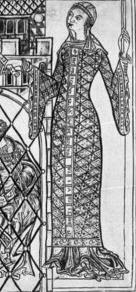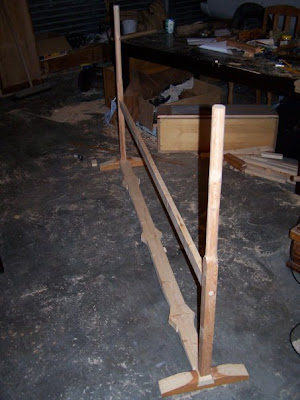Beanie Cap Trim

 Warp: Blue silk
Warp: Blue silkWeft: DMC Cotton
Brocade: Spun gold
Pattern: "Scrolling vine", 13th century cingulum
Cards: 17
Width:1.3cm
Length: Approx. 1.2 metres
What's new: Twill
Beanie caps are one of the distinctive clothing articles of the Germanic region in the 12th century. They can be small and dishlike (kinda like Jewish skullcaps) or more hemispherical. The pictures on the left are from Katherine Barich's picture gallery which has some really awesome pictures, but they aren't well referenced so I'm not sure of their exact source.
 I made a beanie cap a while ago but it fit my head pretty poorly so I decided the make another one that was stiff enough to retain its shape when it is worn. This is the first item of clothing I have made specifically to have tablet weaving on it. There are no extant women's beanie caps that I know of but EPAC lists a French 11th/12th century ecclesiastical skullcap with thin tablet-woven bands down the middle of wider bands, which is what I'm doing.
I made a beanie cap a while ago but it fit my head pretty poorly so I decided the make another one that was stiff enough to retain its shape when it is worn. This is the first item of clothing I have made specifically to have tablet weaving on it. There are no extant women's beanie caps that I know of but EPAC lists a French 11th/12th century ecclesiastical skullcap with thin tablet-woven bands down the middle of wider bands, which is what I'm doing.The pattern is a "Scrolling vine" motif from a cingulum (belt) attributed to St Edmund, Archbishop of Canterbury, 13th century. The pattern can be found on page 132 of EPAC.
All the previous bands I've woven had alternating S- and Z-threaded cards but for this one I tried doing a twill band which means having all the bands threaded the same way. Threading all the cards the same way causes the band to spiral when it's not under tension so it's recommended you have one or two threaded in the other direction at one edge, so the band has 15 Z-threaded tablets and 2 S-threaded ones. Warping your band up in a twill configuration lets you do all sorts of exciting things like 3/1 broken twill, but for this band I'm just doing the unexciting all-cards-turn-at-once thing I've been doing with previous bands. The main difference I've observed with weaving a twill band is that reversing the turn direction is much more obvious on the front of the band than with an alternating S and Z setup so you can't just go changing the direction whenever you feel like it.
The spun gold I'm using for this project is Madeira Metallic No. 10 which is similar to the anchor lame but I think might actually be even thinner. Coverage is not great, but the simplicity of the pattern means this is not a huge issue.


Comments
Post a Comment